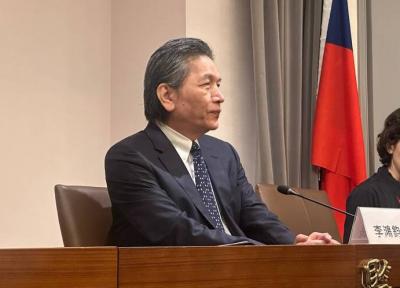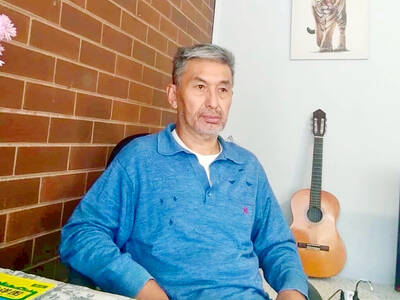Fishing, shipping and marine waste are the three main threats to the natural habitat of Risso’s dolphins, an illustrated book on cetacean scars published by the Kuroshio Ocean Education Foundation said.
Risso’s dolphins are the second-most frequently spotted cetacean species along the coast of Hualien County, the foundation said yesterday, citing data collected from 1998 to 2021.
Studies conducted in other countries showed that cetacean body scars are sustained naturally or through human activities, the foundation said.

Photo courtesy of the Kuroshio Ocean Education Foundation via CNA
Risso’s dolphins are born with a grayish-black body and would sustain light-colored scars while fighting with peers and hunting for food, it said.
“For our study, we chose to study Risso’s dolphins using the research method of photo identification. By identifying the cetacean body scars, we can understand threats facing Risso’s dolphins in their natural habitat,” foundation executive director Lin Dong-liang (林東良) said in a statement.
Foundation researcher Hu Chieh-hsi (胡潔曦) said that they have tracked 50 Risso’s dolphins and found that 19 of them had sustained scars that were suspected to be caused by human activities, likely by the fishing and shipping industries.
Researchers further identified 11 types of cetacean scars.
The most common types were cuts at the front of the dorsal fin and linear strangle marks on the body, he said.
“We suspect that injuries occurred after the dolphins were entangled in fishing nets or struck by ship propellers,” Hu said.
The foundation also tried to identify the causes of the scars by interviewing fishers, who said that Risso’s dolphins were often cut by or entangled in big-mesh drift gillnets.
The device is mostly used by fishers to catch marlins and ocean sunfish, it said, adding that fishers have reported seeing spinner dolphins, false killer whales, Freud’s dolphins and small sperm whales captured in gillnets by accident.
Most cetaceans captured in gillnets die, as they cannot surface to breathe, the foundation said.
Researchers also found that some of the cetacean scars occurred because fishers engaged in longline fishing use squids as bait.
“Risso’s dolphins might take the bait and sustain scars at the corners of their mouths as they struggle to free themselves from the hook. Their dorsal fins or tails might be damaged after being entangled by the fishing line,” the foundation said.
“A severe injury on the dorsal fin or the tail could affect their ability to swim, making it difficult to hunt for food,” it said.
“Banning certain fishing methods and fishing activities is not the only way out,” Lin said.
“Studies in other countries have suggested using flashlights, buzzers and other equipment to avoid accidental injuries to cetaceans, or limiting the speed of ships in cetacean hotspots to mitigate risks,” he said.
Lin said that the research showed that fishing off the east coast has potential adverse effects on cetaceans, adding that long-term monitoring of the marine ecology is necessary.
The current cetacean ecological survey can be used as a basis for the designation of cetacean protection areas and for the government to formulate regulations, the foundation said.
The book can be viewed on the foundation’s official Web site at www.kuroshio.org.tw/newsite.

Taipei has once again made it to the top 100 in Oxford Economics’ Global Cities Index 2025 report, moving up five places from last year to 60. The annual index, which was published last month, evaluated 1,000 of the most populated metropolises based on five indices — economics, human capital, quality of life, environment and governance. New York maintained its top spot this year, placing first in the economics index thanks to the strength of its vibrant financial industry and economic stability. Taipei ranked 263rd in economics, 44th in human capital, 15th in quality of life, 284th for environment and 75th in governance,

The Sports Administration yesterday demanded an apology from the national table tennis association for barring 17-year-old Yeh Yi-tian (葉伊恬) from competing in the upcoming World Table Tennis (WTT) United States Smash tournament in Las Vegas this July. The sports agency said in a statement that the Chinese Taipei Table Tennis Association (CTTTA) must explain to the public why it withdrew Yeh from the WTT tournament in Las Vegas. The sports agency said it contacted the association to express its disapproval of the decision-making process after receiving a complaint from Yeh’s coach, Chuang

Control Yuan Secretary-General Lee Chun-yi (李俊俋) tendered his resignation last night, admitting that he had misused a government vehicle, as reported by media. His resignation was immediately accepted by the Control Yuan. In a statement explaining why he had resigned, Lee apologized for using a Control Yuan vehicle to transport his dog to a pet grooming salon on May 20. The issue first came to light late last month, when TVBS News reported that Lee had instructed his driver to take the dog to the salon. The news channel broadcast photos that it said were taken by an unnamed whistle-blower, which purportedly showed the

A former officer in China’s People’s Liberation Army (PLA) who witnessed the aftermath of the 1989 Tiananmen Square massacre has warned that Taiwan could face a similar fate if China attempts to unify the country by force. Li Xiaoming (李曉明), who was deployed to Beijing as a junior officer during the crackdown, said Taiwanese people should study the massacre carefully, because it offers a glimpse of what Beijing is willing to do to suppress dissent. “What happened in Tiananmen Square could happen in Taiwan too,” Li told CNA in a May 22 interview, ahead of the massacre’s 36th anniversary. “If Taiwanese students or